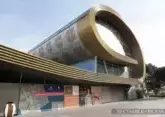Today, the atrium of the new building of Moscow State Institute of International Relations (MGIMO) with the support of the Azerbaijan Youth Organization of Russia and the Azerbaijan Club of MGIMO has opened the exhibition 'Recollection and Reflection' of the member of the Association of Artists of UNESCO Ashraf Heybatov, who answered Vestnik Kavkaza's questions.
- How did you come up with the idea of holding your exhibition at MGIMO?
- I am a former Moscow citizen, although there are no former Baku citizens or former Moscow citizens. After graduating in 1980, I left Baku for the Moscow Olympics - I was lucky to participate in its decoration. In December 1981, with the organizational support of our current president, but then a student of MGIMO Ilham Aliyev, my first exhibition was held in the old building of the institute at Park Kultury. Thirty years later, I was offered to hold an exhibition in a new building, which I'm really pleased about. For me it is a great honor and responsibility to represent my works, being a real artist. There are 35 my works of different periods. In total I had about 20 periods. The name of the exhibition 'Recollection and Reflection' is philosophical. As an artist, I try not to stick out my own self, but create philosophical compositions, where spectators can fill in the rest.
- But nevertheless, what's your message to the audience?
- Chingiz Aitmatov, who was my friend, wrote once that the art of Geibatov is somewhere between East and West. I have deeply national roots, but European artistic plasticity. My last works are connected with those global events that take place. Chingiz Aitmatov gave me a global understanding of what is happening in the world. I'm no longer a narrowly national artist. I have works in the Council of Europe, in the UN. These are the universal compositions, the metamorphoses of the 21st century, the apocalypse of the 20th century, the dialogue of cultures.
- A peacemaking message?
- Yes. I was even awarded the diploma of the Ambassador of Peace for the anti-terrorist panel dedicated to the September 11 attacks in the US. I also received gratitude from the Mayor of New York City, Michael Bloomberg. Now I live in Berlin, so there were many exhibitions at the Konrad-Adenauer-Stiftung, the Berlin Senate. I also made large panels on the national Azerbaijani theme, dedicated to the events of Black January, Khojaly tragedy. This year marks the centenary of the Azerbaijan Democratic Republic, and I am preparing a large exhibition, which possibly will be held in the Bundestag. And in the autumn there will be an exhibition in Rabat.
- What theme was chosen for Morocco?
- I love this country very much, like India, where I've been a number of times. Both the Moroccan series and Azerbaijani landscapes will be presented at the exhibition in Rabat.
- You have the opportunity to compare, because you live in three countries: if we talk about Germany, Russia and Azerbaijan, then how much is art in demand today?
- It is not in demand. We live in the material world. Bread and circuses are in demand, while art and culture are for those who aspire after it, who needs it, who has the need for it. But since there is a lot of poverty, hatred and wars in the world, people don't have time for culture or art. Beauty will save the world or ruin it. As an artist I try to do what I can. When we leave this world, we should leave something worthwhile behind.
- Do you usually work on one project or deal with multiple projects at once?
- I recently finished one great composition for the Council of Europe ... Usually I work on a series of paintings at once. I always have paint and paper on my desk. I come home and do something with it. I am very happy that I studied at the Tbilisi Academy. I was greatly influenced by the Georgian artist Nikolai Ignatov. My first exhibition was held at MGIMO, the second - at the Academy of the Ministry of Internal Affairs of the USSR. I worked with the best Soviet monumentalists - Nikonov, Vladimir and Boris Neklyudov. I received a good education and I believe that the main thing is professionalism.
- How did the Olympics affect your work?
- When decorating the 1980 Moscow Olympics, I worked with the team of Zurab Tsereteli. The Americans boycotted the Olympics, but I was very happy to be on the rostrum. When the Olympic Bear flew out with balloons in the sky, it made tears come out of our eyes. There, in the framework of the cultural program implemented by the Moscow Komsomol, we met with MGIMO students...
- Do you follow the design of other Olympics?
- Of course. I'm a monumentalist. This is my profession - to make paintings, mosaics, figurative compositions. I have global way of thinking. I do not want to paint only flowers or women. It is necessary to be in line with the times. I am really worried about what is happening in the world today. There is an information war, hot wars, a struggle for markets. Those who unleash these wars hide behind democracy. I'm an anti-American. I do not even want to go to America for their expense, because I know what the Anglo-Saxons are doing.
I have great respect for the professor [historian, social scientist, publicist, sociologist] Andrei Fursov. I listen his lectures while working. Listen his lectures and work for 10-15 hours. In fact, he formed me.










